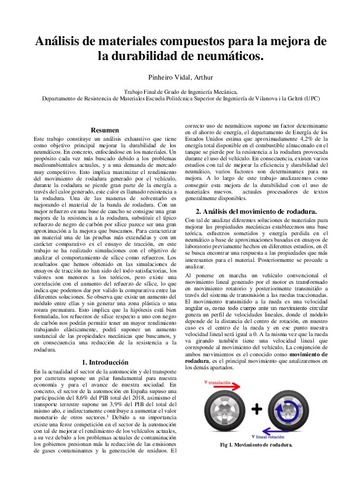Mostra el registre d'ítem simple
Análisis de materiales compuestos para la mejora de la durabilidad de neumáticos
| dc.contributor | Musté Rodríguez, Marta |
| dc.contributor.author | Pinheiro Vidal, Arthur |
| dc.contributor.other | Universitat Politècnica de Catalunya. Departament de Resistència de Materials i Estructures a l'Enginyeria |
| dc.date.accessioned | 2021-01-21T11:24:28Z |
| dc.date.available | 2021-01-21T11:24:28Z |
| dc.date.issued | 2020-10-27 |
| dc.identifier.uri | http://hdl.handle.net/2117/335706 |
| dc.description.abstract | Este trabajo constituye un análisis exhaustivo que tiene como objetivo principal mejorar la durabilidad de los neumáticos. En concreto, enfocándose en los materiales. Un propósito cada vez más buscado debido a los problemas medioambientales actuales, y a una demanda de mercado muy competitivo. Esto implica maximizar el rendimiento del movimiento de rodadura generado por el vehículo, durante la rodadura se pierde gran parte de la energía a través del calor generado, este calor es llamado resistencia a la rodadura. Una de las maneras de solventarlo es mejorando el material de la banda de rodadura. Con un mejor refuerzo en una base de caucho se consigue una gran mejora de la resistencia a la rodadura, substituir el típico refuerzo de negro de carbón por sílice parece ser una gran aproximación a la mejora que buscamos. Para caracterizar un material una de las pruebas más extendidas y con un carácter comparativo es el ensayo de tracción, en este trabajo se ha realizado simulaciones con el objetivo de analizar el comportamiento de sílice como refuerzos. Los resultados que hemos obtenido en las simulaciones de ensayos de tracción no han sido del todo satisfactorias, los valores son menores a los teóricos, pero existe una correlación con el aumento del refuerzo de sílice, lo que indica que podemos dar por válido la comparativa entre las diferentes soluciones. Se observa que existe un aumento del módulo entre ellas y sin generar una zona plástica o una rotura prematura. Esto implica que la hipótesis está bien formulada, los refuerzos de sílice respecto a uno con negro de carbón nos podrán permitir tener un mayor rendimiento trabajando elásticamente, podrá suponer un aumento sustancial de las propiedades mecánicas que buscamos, y en consecuencia una reducción de la resistencia a la rodadura. |
| dc.description.abstract | This thesis constitutes an exhaustive analysis whose main objective is to improve tires durability. Specifically, focusing on materials. A purpose increasingly sought-after due to the current environmental problems, and an extremely competitive market demand. This implies maximizing the performance of the rolling movement generated by the vehicle, during the rolling a lot of the energy is lost through the heat generated, this heat is called rolling resistance. One of the ways to solve it is improving the tread material. With a better reinforcement on with a rubber base a great improvement in rolling resistance is achieved, substituting the typical carbon black reinforcement for silica seems to be a great approximation to the improvement that we are looking for. To characterize a material, one of the most extensive and comparative tests is the tensile test. In this work, simulations have been carried out with the aim of analyzing the behavior of silica as reinforcements. The results that we have obtained in the simulations of tensile tests have not been entirely fulfilling as we wanted, the values are lower than the theoretical ones, but there is a correlation with the increase in the silica reinforcement, which indicates that we can validate the comparison between the different solutions. It is observed that there is an increase in the modulus between them and without generating a plastic area or premature rupture. This implies that the hypothesis is well formulated, reinforcements of silica regarding to one with carbon black will allow us to have a higher performance working elastically, it may suppose a substantial increase in the mechanical properties that we seek, and consequently a reduction of rolling resistence. |
| dc.language.iso | spa |
| dc.publisher | Universitat Politècnica de Catalunya |
| dc.subject | Àrees temàtiques de la UPC::Enginyeria dels materials::Desgast de materials |
| dc.subject.lcsh | Tires |
| dc.subject.other | Neumático |
| dc.subject.other | Materiales |
| dc.subject.other | Caucho |
| dc.subject.other | Compuestos |
| dc.subject.other | Sílice |
| dc.subject.other | Durabilidad |
| dc.subject.other | Rodadura |
| dc.subject.other | Energía |
| dc.subject.other | Tracción |
| dc.subject.other | Simulación |
| dc.subject.other | Tire |
| dc.subject.other | Material |
| dc.subject.other | Rubber |
| dc.subject.other | Composites |
| dc.subject.other | Silica |
| dc.subject.other | Durability |
| dc.subject.other | Rolling |
| dc.subject.other | Energy |
| dc.subject.other | Tension |
| dc.subject.other | Simulation |
| dc.title | Análisis de materiales compuestos para la mejora de la durabilidad de neumáticos |
| dc.type | Bachelor thesis |
| dc.subject.lemac | Pneumàtics |
| dc.identifier.slug | PRISMA-154851 |
| dc.rights.access | Open Access |
| dc.date.updated | 2020-12-15T13:27:33Z |
| dc.audience.educationlevel | Grau |
| dc.audience.mediator | Escola Politècnica Superior d'Enginyeria de Vilanova i la Geltrú |
| dc.audience.degree | GRAU EN ENGINYERIA MECÀNICA (Pla 2009) |




